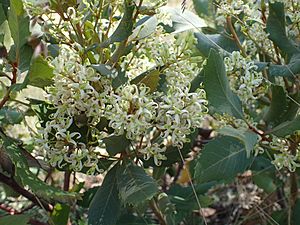Tree lomatia facts for kids
Quick facts for kids Tree lomatia |
|
|---|---|
 |
|
| Lomatia fraseri growing near Cathedral Rock National Park | |
| Scientific classification | |
| Genus: |
Lomatia
|
| Species: |
fraseri
|
| Synonyms | |
|
Tricondylus fraseri (R.Br.) Kuntze |
|
Lomatia fraseri, also called tree lomatia or silky lomatia, is a special plant from eastern Australia. It belongs to the Proteaceae family, which includes many unique Australian plants. This plant can grow as a large bush or a small tree. It usually reaches about 8 to 11 meters (25 to 36 feet) tall.
One cool thing about Lomatia fraseri is its leaves. They can look very different, even on the same plant! In summer, it grows beautiful cream or white flowers. You can find this plant in the mountainous areas of Victoria and New South Wales. It often grows near the edges of rainforests, in valleys, or in open heathland. After a bushfire, it can regrow from a special underground part called a lignotuber.
Contents
What Does Tree Lomatia Look Like?
Lomatia fraseri is a tall shrub or small tree. It can grow up to 11 meters (36 feet) high. But in windy or open areas, it might be much smaller. For example, in Werrikimbe National Park, it can be as short as 50 centimeters (20 inches).
Leaves of the Silky Lomatia
The leaves of Lomatia fraseri are long and shaped like a spear or an oval. They are usually between 6.5 and 15 centimeters (2.5 to 6 inches) long. The edges of the leaves often have small teeth, but sometimes they are smooth or deeply cut. The top side of the leaves is green and smooth. The underside is yellowish-green and feels silky. This is why it's sometimes called "silky lomatia"!
Flowers and Fruits
The flowers of Lomatia fraseri grow in long clusters called racemes. These clusters can be up to 12 centimeters (5 inches) long. The flowers are white or cream-colored. They usually appear between December and February in Australia. After the flowers, dark grey seed pods grow. These pods are about 1.5 to 3 centimeters long. They are ready to open and release seeds from April to October.
Where Does Tree Lomatia Grow?
Lomatia fraseri grows in two main areas in Australia. One area is in northern New South Wales, near Tenterfield. The other area stretches from southern New South Wales, around Budawang National Park, down into eastern and central Victoria. It can be found as far west as the Otway Ranges.
This plant likes to grow in mountainous places. It often lives at the edges of rainforests. In Victoria, you might find it in valleys. In New South Wales, it grows more in open woodlands and heathlands.
How Does Tree Lomatia Survive?
Lomatia fraseri has a special way to survive bushfires. It can regrow from a hidden underground stem called a lignotuber. This means that even if the top part of the plant burns, the roots and base can sprout new shoots. This helps the plant come back to life after a fire.
Scientists have studied how logging might affect these plants. They think that cutting down trees and removing burnt wood after fires could harm Lomatia fraseri populations.
Growing Tree Lomatia in Your Garden
The different shapes of Lomatia fraseri's leaves make it an interesting plant for gardens. It can grow in sunny spots, but it prefers a bit of shade. When the plant is young, it likes extra water. Adding organic mulch around its base can also help it grow well.
This plant can handle some frost, which means it can survive in cooler areas. You can grow new plants from seeds or by taking cuttings from an existing plant.
Uses of Tree Lomatia Wood
In the past, people used the wood from Lomatia fraseri. It was known to be light and strong, and easy to work with. In the 1800s, it was used to make furniture and window frames.

